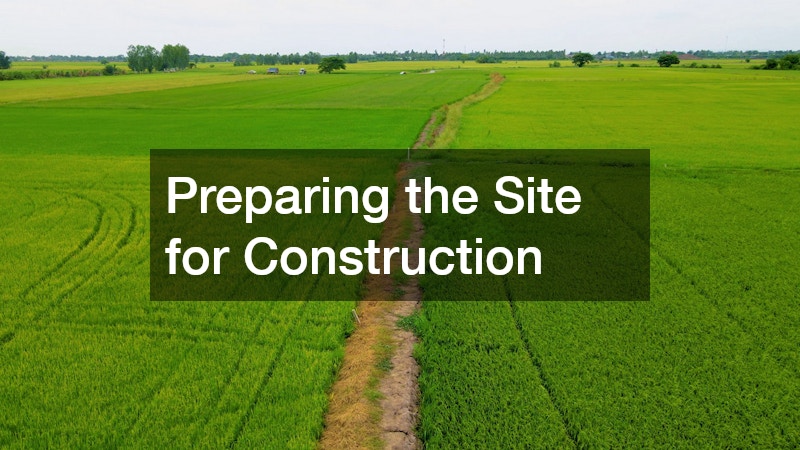
In today’s ever-evolving housing market, more individuals and families are seeking alternatives to traditional home purchases. One increasingly popular option is building a custom home designed specifically to match their unique lifestyle and preferences. Enter the concept of build to suit homes, a custom construction model that allows future homeowners to tailor every detail—from the floor plan to the finishes. Unlike buying pre-built homes for sale, building your own home gives you complete control and ensures that your investment reflects your personal tastes and functional needs.
The process of creating a build to suit home can be both exciting and daunting. It involves a series of steps that range from selecting the right piece of land to finalizing the design and managing a team of contractors, including professionals like electricians, roofers, and septic companies. Throughout this journey, clients often work closely with local vendors, such as a local mover or a concrete service, and manage logistics that may include local dumpster rentals to handle construction debris.
This comprehensive guide breaks down the custom home process into ten detailed stages. We’ll explore everything from land acquisition and design planning to selecting materials and working with specialty providers such as a well drilling company or residential roofing companies. Whether you’re building a suburban dream home or a rural retreat, understanding the workflow of build to suit homes ensures that you can navigate the process confidently and efficiently. Let’s walk through each critical phase of bringing your dream home to life.
1. Acquiring the Right Land
The journey to building your dream home begins with purchasing land. The location, size, topography, and zoning regulations of a property all play a pivotal role in shaping the final design and budget of build to suit homes. Whether you’re considering a rural plot or a lot in a growing development, choosing the right land is crucial.
Before buying, conduct a thorough land survey and consult local authorities about building restrictions. Factors like access to utilities, soil quality, and natural drainage can affect both design and construction costs. Collaborating with a seasoned real estate agent who understands the nuances of build to suit homes can save time and prevent costly mistakes.
It’s also important to envision how the property will support future infrastructure—driveways, wells, septic systems, and landscaping. Remember, a beautiful home requires a suitable foundation. Once you’ve secured a plot that aligns with your goals, you’re ready to move on to design planning, the heart of any build to suit homes project.
2. Designing Your Custom Home

Once your land is secured, the next step is to design your dream layout. This is where the magic of build to suit homes truly begins. You can work with architects or design firms to create a floor plan that reflects your lifestyle. Consider elements such as open-concept living, natural lighting, energy efficiency, and accessibility.
This phase also includes choosing a building structure. Some homeowners opt for pre engineered steel buildings for their durability and quick installation. Steel buildings are becoming a popular foundation for modern build to suit homes because they offer flexibility in design while being cost-effective.
Make sure your home design adheres to local building codes and accommodates features like a garage, porches, or additional storage. Take this opportunity to explore smart home technology and energy-efficient materials. By focusing on customization, you’re ensuring the final product is a perfect match for your daily living needs.
3. Setting Up Utilities and Infrastructure
Before breaking ground, you’ll need to establish the basic infrastructure for your build to suit home. This includes water, electricity, gas, and waste management systems. Hiring a trusted well drilling company is often necessary for properties in rural areas without municipal water access.
You’ll also need to coordinate with an electrician to design and implement a safe and code-compliant electrical system. This phase is crucial—poor infrastructure planning can result in costly delays or safety issues down the line.
Another consideration is the sewage system. In non-urban areas, you’ll need the expertise of a septic company to install and manage wastewater systems. All of these elements must be coordinated early to align with construction timelines. Having reliable professionals from each trade ensures your build to suit homes project runs smoothly from the ground up.
Additionally, consider your future energy needs and whether solar panels or backup generators should be included at this stage. Planning for expansion or emerging technologies can help you stay ahead and avoid future retrofitting. Infrastructure is the unseen backbone of your home, so thorough planning and expert help are essential to long-term success.
4. Preparing the Site for Construction

With utilities planned, it’s time to prepare the site. This is where your concrete service provider comes in. Proper groundwork sets the stage for a structurally sound home. The land must be cleared, leveled, and excavated to accommodate foundations, driveways, and any planned outdoor features.
Once cleared, your concrete service will pour footings and slabs according to your blueprint. The quality of this foundational work is vital, as it impacts everything built above it. Investing in skilled professionals ensures your build to suit homes project won’t suffer from structural problems later.
Site prep also includes grading the land to direct water away from the structure and scheduling necessary inspections. A well-prepared site minimizes future complications and sets a positive tone for the rest of the construction process.
This phase may also involve soil testing, temporary utility connections, and erosion control measures to meet environmental and safety standards. These added precautions help your project move forward without delays and contribute to a smoother overall build.
5. Managing Waste and Construction Debris
Construction generates a significant amount of waste. Partnering with local dumpster rentals is essential to keep your site organized, safe, and compliant with regulations. Proper debris management during a build to suit homes project prevents delays and creates a better working environment.
Dumpster rentals allow for the disposal of framing materials, packaging, unused concrete, and more. Different phases of construction will generate different types of waste, so selecting the right dumpster size and schedule is key.
Using professional local dumpster rentals services also helps you remain environmentally responsible. Many providers separate recyclable materials from landfill waste, adding a sustainable edge to your project. Clean sites lead to better productivity, helping your build to suit homes project stay on track and within budget.
Consider setting up clearly labeled bins for sorting materials on-site, and work with providers who offer flexible pick-up schedules. These simple practices help ensure compliance and reduce the environmental impact of your project.
6. Framing and Roofing

With the foundation in place and waste managed, framing begins. This stage brings the structure of your build to suit home to life. Contractors frame walls, install windows and doors, and prepare the skeleton for roofing and siding. The design and framing process must strictly follow your blueprints and pass inspection.
Once the structure is framed, residential roofing companies step in to install a roof that protects your home from the elements. Whether you choose asphalt shingles, metal roofing, or another material, quality workmanship is crucial.
This phase is often one of the most visually rewarding as you see your build to suit homes vision take shape. Roof installation also marks the transition from exterior to interior work, signaling that your custom home is well on its way to completion.
You may also choose to include additional framing for exterior features like decks, porches, or attached garages. At this point, structural inspections take place to confirm everything meets local codes before progressing to the next construction stages.
7. Finalizing Interior Systems
Interior systems include plumbing, HVAC, electrical wiring, and insulation. This is where your electrician becomes a central figure again. Properly planned electrical layouts will allow for smart home devices, lighting preferences, and appliance placement.
This stage also involves plumbing rough-ins for kitchens and bathrooms. All systems must comply with local codes and be inspected before walls can be closed.
Heating, ventilation, and air conditioning systems should also be carefully integrated for maximum efficiency and air quality. Selecting the right materials and components at this stage can improve energy savings and reduce long-term maintenance. Insulation, too, plays a vital role in comfort and efficiency, especially in extreme climates.
Interior systems are the veins of your build to suit homes project. Accurate planning ensures comfort, energy efficiency, and long-term functionality. Don’t cut corners in this stage—quality now prevents headaches later.
8. Moving In and Final Touches
After final inspections and certificate of occupancy approval, it’s time to move in. Hiring a local mover ensures your transition is smooth and efficient. Professional movers can handle fragile items and furniture with care, protecting your new investment.
During this final stage, landscaping, painting, and minor installations take place. Walk through the house to create a final punch list and communicate any last adjustments to your contractor. You may also take time to install window treatments, test all appliances, and set up utilities and internet services. These finishing touches help transition the house into a fully functional home.
The move-in process marks the exciting end of your build to suit homes journey. A trusted local mover can significantly reduce the stress and effort required, allowing you to enjoy your new custom space sooner.
9. Maintaining Your New Home
Even custom homes require maintenance. Routine inspections and servicing keep systems running efficiently. Partnering with local professionals like your original septic company, electrician, or residential roofing companies can provide continuity and peace of mind.
Maintain detailed records of all installations and warranties. Periodically review these with your service providers to ensure coverage remains valid and effective. Regular cleaning of gutters, seasonal HVAC servicing, and prompt attention to minor roof or plumbing issues can prevent costly future repairs.
Ongoing care ensures your investment in build to suit homes continues to serve you well for decades. From gutters to HVAC filters, upkeep preserves the beauty and functionality of your dream home.
10. Reflecting on the Journey

The process of creating build to suit homes is full of decisions, coordination, and creativity. Each stage—though sometimes complex—adds to the satisfaction of living in a space that is entirely your own.
You’ve worked with everyone from a well drilling company and concrete service, to local dumpster rentals and residential roofing companies. Each played a role in bringing your blueprint to life. The result is a home tailored exactly to your lifestyle, values, and goals.
Along the way, you’ve made meaningful choices that reflect your priorities—whether incorporating energy-efficient systems or planning future growth. You’ve overseen details from foundation to final finishes, empowering you with knowledge and pride in every inch of your property.
Embracing the build to suit homes journey isn’t just about construction—it’s about crafting a legacy. Whether for your growing family or as a personal retreat, your custom-built home is a long-term investment in comfort, design, and happiness.
Building a custom home is one of life’s most rewarding experiences. The journey of build to suit homes begins with a vision and ends with a reality uniquely tailored to your needs. From selecting land and creating a design, to working with tradespeople like a septic company, electrician, or local mover, every decision contributes to the final masterpiece.
Unlike browsing homes for sale, the build to suit homes process places you at the center of every choice—from layout and roofing to wiring and water systems. You’ll coordinate with a concrete service to lay the foundation and hire local dumpster rentals to manage waste efficiently. Your collaboration with professionals ensures the end result reflects both quality and character.
This guide has walked you through each major milestone in the build to suit homes process, from conceptualization to move-in. With attention to detail, reliable service providers, and careful planning, your dream home is more achievable than ever.
If you’re ready to take control of your living space and design every detail to fit your lifestyle, now is the perfect time to explore the possibilities of build to suit homes. The investment in custom building isn’t just financial—it’s personal. And when done right, it pays dividends in satisfaction, style, and lifelong comfort.


